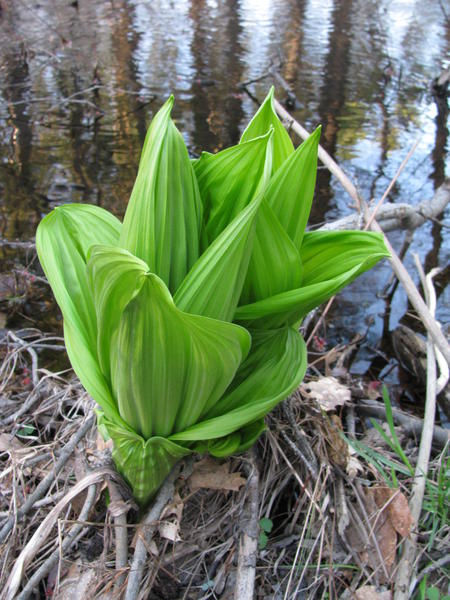On Saturday, I took a hike down to Sandogardy Pond with Beth, David, and Penny. I took photos along the way and while there, but haven’t gotten around to getting them off the camera until tonight. I also have been walking around in my woods snapping away over the past couple of days. Here’s what I’ve found:
Coltsfoot (Tussilago farfara) was once considered a premium cough remedy. It has not proven to be effective by modern science.
The photo above is False Hellebore (Veratrum viride). It looks like it would be really good to eat, with all those leafy lush greens. But that would be a mistake as it’s pretty toxic, causing the body to reject it almost immediately via emesis. Failure to purge is fatal. Some Native American tribes used this as a bravery test when selecting a new chief. The candidates would eat some, and then bravely try to keep it down. Last one to barf would be named the bravest, and thus, the new chief. But sometimes such bravery proved fatal, so they would have to go with the second-bravest-but-slightly-wiser candidate instead.
I’m not good a identifying violets down to the species level. There are a lot of them to choose from. This was in my backyard.
The blueberry blossoms are almost ready to open.
This little beast is carnivorous. The leaves exude a mucus that catches bugs. And here I thought all carnivorous plants were exotic and probably tropical. Never expected to find them in my backyard.
When I saw these on Saturday, I knew it was spring.
I think this is about the most stunning wildflower in bloom at my place right now. The white petals are actually sepals. The actual petals are those yellowish clubs hanging out between the stamens. This plant gets its name from its roots which look like little gold threads. Chewing on them is purported to be an effective treatment for mouth sores, which is where its alternate name – canker root – comes from. I took a lot of shots of these. Here’s another:
None of the leaves around this flower belong to this plant. I didn’t take any shots of the foliage today (shrug), but they usually show up as three wedge shaped forms joined at a central point with jagged edges on the opposite side. The leaves here are from the star flower (Trientalis borealis), but those aren’t in bloom yet.








May 3, 2011 at 11:51 pm
My, that is an explosion! It’s nice to see the Butterwort and Goldthread: we don’t have those here.
May 4, 2011 at 12:04 am
It was rather sudden. Last week there were only a couple of species in bloom, and this week it’s a different story. In addition to the Star Flower, we should see Indian Cucumber and Black Chokeberry soon. I’m looking forward to that.
May 6, 2011 at 7:26 am
Wow, you have a lot of plants we don’t have. The coltsfoot is blooming here, and maybe the goldthread, Guess I need to go out and look today, while the sun is shining.